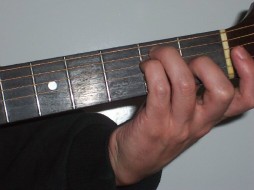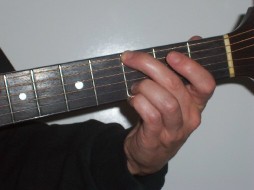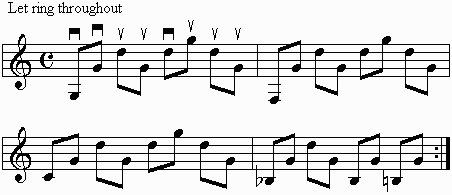 |
|
Lesson 10 |
||||||||||||||||||||||||||||||||||||
|
This lesson we will take a look at the arpeggio and different ways
to play an arpeggio on the fretboard. Review lesson 9 |
||||||||||||||||||||||||||||||||||||
|
|
||||||||||||||||||||||||||||||||||||
|
Intervals Review the other intervals we have learned from Lesson 4 |
||||||||||||||||||||||||||||||||||||
5 half steps= perfect 4th 6 half steps = tritone 7 half steps = perfect 5th |
 |
 |
 |
|||||||||||||||||||||||||||||||||
|
A tritone can also be called an augmented 4th or diminished 5th You should practice singing all of the intervals you have learned so far. |
||||||||||||||||||||||||||||||||||||
|
|
||||||||||||||||||||||||||||||||||||
|
Scales - F Major So far we have built C major, G major and D major scales. We know: In this lesson we will build an F major scale. When we use the WWHWWWH major scale formula, we end up with a scale from F to F with a Bb. So the key of F major (relative minor would be D minor) has one flat.
We must use all 7 alphabet letters when we build major and minor scales and that is why we would not call the 4th note an A# (even though it is the same pitch) |
F Major in
|
|||||||||||||||||||||||||||||||||||
|
The two forms to the right should look familiar to you. The first is your open C scale from lesson 2 moved to 5th position to give us an F major scale. This form was also reviewed with a D scale in lesson 6. The other is your 2nd position C scale form from lesson 4. Move it to 7th position and use the same fingering and you have an F major scale. It would also be a good idea to take out the 4th and 7th (Bb and E) and practice these scales as pentatonic too. |
F Major in
|
F Major in
|
||||||||||||||||||||||||||||||||||
|
|
||||||||||||||||||||||||||||||||||||
|
Chords - Inversions of a Major triad (F major on strings 2 3 4) We have learned building any major chord uses the 1st, 3rd and 5th degree of the major scale with the same name. So in the case of the F major scale above, we end up with F, A and C. When stacked space space space with F (also known as the root of chord) on the bottom, it is called root position (it could also be stacked line line ine like we will see with G in Lesson 12). If we move the F one octave higher we have 1st inversion. If you then move the A an octave higher you have 2nd inversion and from there if you move the C an octave higher you are back to root one octave higher than you started.
There are different ways we can play the above inversions on the guitar but for now let us keep them all on strings 2 3 4. Root will be played in 1st position. To move to 1st inversion we will move the F one octave higher to the 6th fret (use your 2nd finger) of your B string. The A and C are going to be the exact same pitches as in root but this time we will play them in 5th position. So if you see the A on the second space of the staff (FACE), you can play it on the 2nd fret of your G string or 7th fret of your D string. The same goes for C, the 1st fret of your B string C is the same as the 5th fret or your G string C. Now to get to 2nd inversion we move the A an octave higher. C and F are the same pitches but in 8th position. Then if we move the C an octave higher, we are back to root but in 13th position and one octave higher from where we started. Notice on the staff above it is now line line line. |
||||||||||||||||||||||||||||||||||||
|
||||||||||||||||||||||||||||||||||||
|
|
||||||||||||||||||||||||||||||||||||
|
Chords - The Bar chord Also spelled barre chord. In lesson 8 we learned an E chord. Let's look at it again but this time let's play it with fingers 2 3 4 instead of 1 2 3. Next we will move the chord one half step higher.
|
 |
|||||||||||||||||||||||||||||||||||
|
So to do that we lay our first finger across the fretboard to act as the nut. This is a tough chord for most people. It takes some time before all 6 strings sound and even more time for it to become comfortable. We will use it in a song in a later lesson but for now you should try playing it a couple times each day. Even if it doesn't ring so well :) |
 |
|||||||||||||||||||||||||||||||||||
|
|
||||||||||||||||||||||||||||||||||||
|
Chords - G5 (open) Now for an easier chord, a new way to play a G power chord. This will give us an even bigger sound than the previous power chords we have learned because we will be playing 5 strings. If you remember a power chord is made from a root and a perfect 5th higher. So if we were to build a G power chord we would have a G and a perfect 5th higher, which would be D. You could find this by finding a perfect 5th (7 half steps) higher than G or think of the 5th note of a G scale. Our new big power chord will be nothing but G and D's. |
||||||||||||||||||||||||||||||||||||
 |
 |
|||||||||||||||||||||||||||||||||||
| The chord to the right we learned as GtypeII but if you take the pressure off the B, you will have a new way to play a G power chord. Don't take your finger off completely because we don't want to hear the A string. |  |
|||||||||||||||||||||||||||||||||||
|
|
||||||||||||||||||||||||||||||||||||
|
Arpeggio What are the notes from a G major chord? 1st, 3rd and 5th degree of a G major scale. |
||||||||||||||||||||||||||||||||||||
 |
 |
|||||||||||||||||||||||||||||||||||
|
You should end up with a G, B and D. Let's take a look at a fun way to play an arpeggio while working on shifting, natural picking and learning these 3 notes on the fretboard. With the fretboard below you are working on shifting from 2nd position to 4th position and then to 7th position. You should use the same fingers each time you shift. |
||||||||||||||||||||||||||||||||||||
|
In all 3 positions: 2nd finger will play the G
|
 |
 |
 |
|||||||||||||||||||||||||||||||||
 |
||||||||||||||||||||||||||||||||||||
|
The pick pattern below shows us natural picking (also known as economy picking). Notice we down pick the G and B every time because we are switching from string to string. We always up pick the D because it is on the same string as B. You should also practice alternate picking it.
Midi File - right click to open in new window. If you have Cakewalk or Band in the Box or other such program you can speed up or slow down file as needed. |
||||||||||||||||||||||||||||||||||||
|
The video below should demonstrate the exercise: G Major Arpeggio in 7th position |
||||||||||||||||||||||||||||||||||||
|
The above arpeggio had us in 7th position on strings 1 and 2. You can stay in that position and come back the arpeggio form we learned in lesson 6 |
 |
|||||||||||||||||||||||||||||||||||
|
Improvising This Collective Soul riff (below) can
be a lot of fun to improvise over depending on how we treat the chords.
We could use the basic idea of putting our 1st finger on a G and play
the most popular pentatonic shape, 1-4, 1-3,1-3,1-3,1-4,1-4. This would
give us a G minor pentatonic sound. We could also put our pinky on a
G and use the same pentatonic pattern. This would give us a G major
pentatonic sound. I think you will find the B natural in the scale will
clash to much with the Bb in the last part of the riff. Slash Chords Slash chords are chords that have a note in the bass other than the root. The bass note can be anything but are quite often seen with the 3rd or 5th degree of the chord on the bottom. The Collective Soul riff below explores G/F and next lesson we will explore Gm/Bb. Collective Soul - Main riff from December
Extras Here is a great Red Hot Chili Pepper tune I made a video lesson for. It uses part of the F chord and will be a great one for getting ready to play the bigger 6 string version: Another good video lesson I did with the smaller easier F chord is: Here is a cover I did with student Ashley Taylor: Call It Off cover
Scales: F major in open, 5th and 7th position
You don't have to play every scale everyday. Just be sure to get through all of them at least twice in a week. You should also try to include the pentatonics. Chords - Be sure to add the F chord to
your practice routine as we will learn a few songs using it in the up
coming lessons. Arpeggio - the new G moveable arpeggio, practicing moving it from 2nd to 4th to 7th position and then while in 7th review the form you learned in lesson 6 (2nd position D major). It will now be a 7th position G major arpeggio.
Next Lesson - Lesson 11 |
||||||||||||||||||||||||||||||||||||
| Vancouver British Columbia Canada 604 357-3551 http://www.musiclearning.com |










